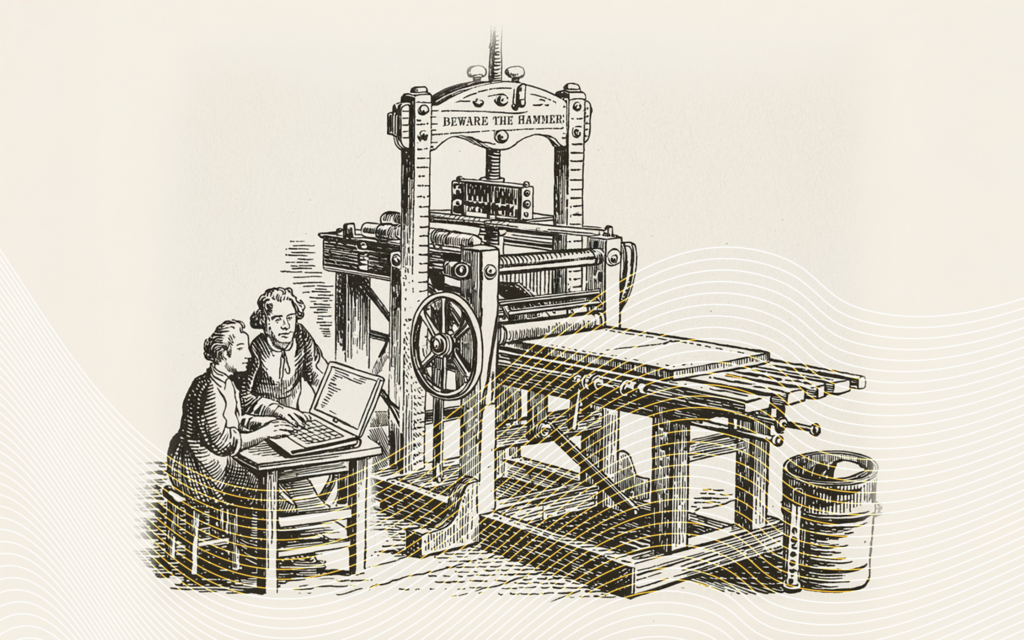
Malleus Maleficarum
The Hammer of Machines
By: Jack Polly, Senior Copywriter
When I was in college, one of the first classes I had to take for my major was an introductory lecture series called Mass Media & You, with a class code that was something like MMC1101. It was held in a dungeon-esque hall that, along with damp bricks and a distinct lack of windows, offered enough seats for six-hundred odd under-rested underclassmen. There was enough distance between the professor and the seats for students to spend their Tuesday and Thursday mornings focusing on social media, blogs, and flash games without paying heed to the Communications School’s director, sweat illuminated by a projector’s bulb, rattling off information I don’t remember, or perhaps never learned in the first place. There was one question, however, that managed to elicit a droning response from every student in the class:
What invention is Johannes Gutenberg credited with?
There are those among you that are quick to say, perhaps smugly, and definitely incorrectly, that the answer is the printing press. I appreciate you participating at all. The correct answer, as hundreds of USF Mass Communications alumni can probably still tell you, is “movable type.” Before Gutenberg, printing was done through a method called “block printing,” where a mold of a full page was created, covered in ink, and dropped down, transferring an entire page’s worth of information at once. Yes, ideas could go into print, but the cost of developing an entire page’s block was high, which dissuaded new ideas that may not have massive funding from being put out. The beauty of movable type was democratized information. Work was allowed to go out—it was much easier to set individual words and rearrange those words in new and exciting ways. This is often considered to align with the advent of a more learnéd society, with science and literature flowing freely through civilization. But along with a heap of pamphlets on medicine and preservation of King and country came pieces like Malleus Maleficarum—translated directly as “The Hammer of Evil,” but more accurately meaning “The Hammer of Witches.”
Malleus Maleficarum lived to see 26 editions being put into print with more than 50,000 copies distributed in total. To put that into perspective with some population scaling from the 1400s to today, Malleus Maleficarum would be a modern best-selling non-fiction novel. A bestseller written on how to understand, identify, and punish those who are suspected of practicing witchcraft. The book fueled mass hysteria, inspiring thousands of executions across Europe. Here’s an excerpt that stands out:
“Witches can, through the power of the Devil, cause children to wither in the womb, blight the fruits of the earth, and ride through the air on beasts or sticks, unseen by human eyes.”
kids could you lighten up a little
I bring up Malleus not to convince you to look for those that ride through the air on beasts or sticks, but to remind you that just because information is new and accessible, doesn’t mean it’s accurate. We learned this with the spread of literacy. We learned it with the advent of social media. And we’re learning it again with artificial intelligence. Oh, sorry, did you think you were going to get to read a blog that wasn’t going to mention AI? In the current year? Think again. I also don’t say any of this to tell you to not use AI. I use AI almost every day—at this point, ChatGPT is like my little buddy. It knows my routine, my personality, and helped me pick which color to paint my living room over the weekend (Behr’s “Cinnamon Crunch,” if you were curious). I can’t imagine my life without him. I only ask you to think twice about everything that you’re reading, AI doubly so. Like many new technologies that focus on production, the goal seems to be quantity of output, not quality. That yields, above all else, an industrialized sort of mediocrity.*
Luckily, agencies like &Barr are striving for ethical, mindful use of AI. We’ve got good people here at 600 E Washington St, and when you put the right tool in somebody’s hand, you accomplish something even greater. Because at the end of the day, that’s what AI is—another tool. And I don’t care how much a hammer costs or what it’s made out of if you don’t know how to swing it. Because if the wrong person is holding it, it’s going to do more harm than good. To see how we swing our hammer, check out our work.






